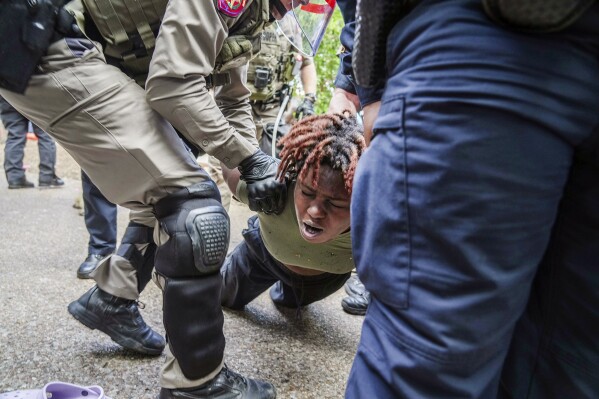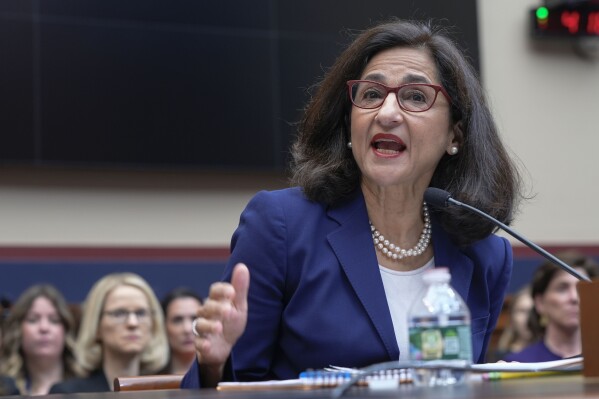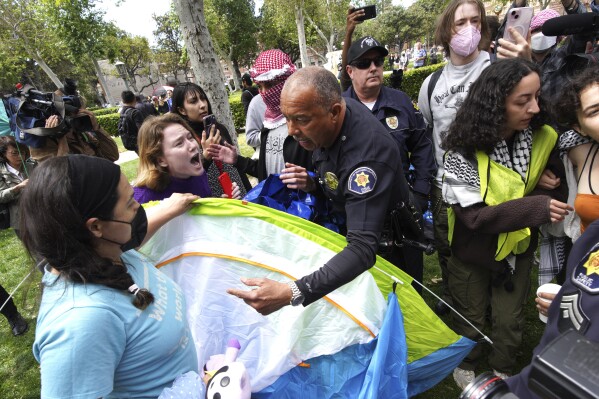Carefully planned and partly improvised: inside the Columbia protest that fueled a national movement
NEW YORK (AP) — Months before they pitched their tents on Columbia University’s main lawn, inspiring a wave of protest encampments at college campuses nationwide, a small group of pro-Palestinian student activists met privately to sketch out the logistical details of a round-the-clock occupation.
In hours of planning sessions, they discussed communications strategies and their willingness to risk arrest, along with the more prosaic questions of bathroom access and trash removal. Then, after scouring online retailers and Craigslist for the most affordable options, they ordered the tents.
“There’s been a lot of work, a lot of meetings that went into it, and when we finally pulled it off, we had no idea how it would go,” said Columbia graduate student Elea Sun. “I don’t think anyone imagined it would take off like it did.”
Inspired by the protests at Columbia, hundreds of students have set up protest encampments on at least a dozen other college campuses across the country to protest lsrael’s actions in the war with Hamas. Among other demands, they are calling for their schools to cut financial ties with Israel and the companies supporting the conflict. The protests come as universities are winding up the spring semester and preparing for graduation ceremonies.
Those involved with the Columbia protest, also known as the “Gaza Solidarity Encampment,” describe their organizing efforts as both meticulously planned and heavily improvised. They say the university’s aggressive tactics to quell the movement have only lent it more momentum.



Basil Rodriguez, a Columbia student affiliated with Students for Justice in Palestine, a group the university suspended in November, said organizers had been in touch with students at other schools about how to erect their own encampments. About 200 people joined one call with students on other campuses.
To attract the most news media attention, the organizers timed the Columbia encampment to coincide with university president Minouche Shafik’s testimony last Wednesday to a congressional panel investigating concerns about antisemitism at elite colleges.
The following day, officers with the New York police department flooded the campus, dismantled the tents, arrested more than 100 activists, and threw out their food and water. Shafik said she had taken the “extraordinary step” of requesting police intervention because the encampment had disrupted campus life and created a “harassing and intimidating environment” for many students.
That decision fueled currents of rage that quickly washed across the country, prompting students at other college campuses to set up their own protest encampments.
“We’re standing here today because we’re inspired by the students at Columbia, who we consider to be the heart of the student movement,” Malak Afaneh, a law student and spokesperson for the 100-student-strong encampment at the University of California, Berkeley, said Tuesday.
Just hours after last week’s arrests, some Columbia students jumped a fence to an adjacent lawn, wrapping themselves in blankets until a new provision of tents eventually arrived. In the week since police cleared the first encampment, the second iteration has grown not only larger, but more organized.
“The university thought they could call the police and make the protesters go away. Now we have twice as many protesters,” said Joseph Howley, an associate professor at Columbia and supporter of the encampment. “The students have experienced a ratcheting up of repression that has prompted them to escalate with their own tactics now.”
The mood was lively and upbeat on Wednesday, as some students passed out matzo left over from a Passover seder and knafeh, a flaky Middle Eastern pastry dropped off by a supportive Palestinian family from New Jersey.
Others attended a teach-in delivered by a Columbia alumnus involved in the anti-apartheid movement in the 1980s, pulled books off the shelf of a “People’s Library,” and helped themselves to art supplies from a craft table. Those who’d spent the night in one of roughly 80 tents said they used the bathrooms at nearby university buildings. (An earlier experiment with a “camp toilet” had been quickly abandoned.)
At the nearby law library, a group of negotiators representing the protesters has been meeting intermittently with university administrators since Friday to discuss their demands, as well as amnesty for students and staff facing discipline for participating in the protests.
Those talks broke down on Tuesday night, according to the lead negotiator, Mahmoud Khalil, after he said the university threatened to send in police and the National Guard if the encampment wasn’t gone by midnight. Hundreds of students and faculty quickly packed onto the lawn in the largest numbers since the start of the demonstration.
Overnight, the university backtracked, giving demonstrators a 48-hour extension if the group agreed to block nonstudents from the encampment and remove a certain number of tents. A spokesperson later denied that the university had suggested calling the National Guard.
While there have been confrontations and allegations of antisemitic activity outside the university’s gates, police described students inside the encampment as peaceful and compliant.
Organizers said they’d dismantled a few tents for fire safety reasons, but were still admitting outsiders to the encampment as long as they abided by community guidelines, including: no photographs, littering or engaging with counter-protesters. They said they had no plans to leave until their demands were met.
Opponents of the encampment say it has destabilized campus life, forcing the university to barricade many of its entrances to nonstudents while putting Jewish students in harm’s way.
Omer Lubaton Granot, a graduate student from Israel who is studying for a master’s degree in public administration at Columbia, said the university should have taken “more assertive action” in clearing the encampment. He accused protesters of embracing an aggressive anti-Zionist stance that made him feel unsafe.
“They’re canceling my identity and they’re threatening me as an Israeli and as a Jew,” he said.
Officials including President Joe Biden and Democratic New York Gov. Kathy Hochul have also condemned what they described as antisemitism associated with the protests. On Wednesday, Republican House Speaker Mike Johnson held a news conference at Columbia to denounce the encampment, drawing jeers from many students.
Mayor Eric Adams, a Democrat, noted this week that many of the students were sleeping in the same brand of tents, which he said could indicate that “outside agitators” were responsible for arranging the encampment, a baseless claim that had earlier spread among some right-leaning news media outlets and New York police officials.
Layla Saliba, a Palestinian American student at Barnard, Columbia’s sister college that shares some facilities with the university, dismissed the idea. She said the students leading the protest were mostly “nerds” who enjoyed lengthy meetings and consensus building.
“To imply this is AstroTurfed or paid off, when it has actually been students laying the groundwork for this from the very beginning, is ridiculous,” she said.
As for the similarity of the tents, she said the brand had been ordered in bulk by student organizers. As the encampment has expanded, students have brought their own camping gear, she said, pointing to the varied sleeping arrangements on the bustling lawn.
“There’s apparently a lot of people here at Columbia who like to camp,” she added. “I’ll admit I was a bit surprised by that.”
Disclaimer: The copyright of this article belongs to the original author. Reposting this article is solely for the purpose of information dissemination and does not constitute any investment advice. If there is any infringement, please contact us immediately. We will make corrections or deletions as necessary. Thank you.




